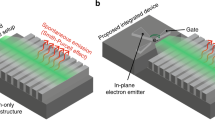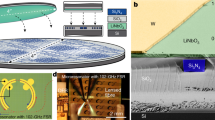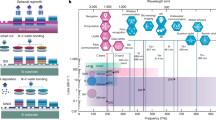Abstract
Silicon lasers have long been a goal for semiconductor scientists, and a number of important breakthroughs in the past decade have focused attention on silicon as a photonic platform. Here we review the most recent progress in this field, including low-threshold silicon Raman lasers with racetrack ring resonator cavities, the first germanium-on-silicon lasers operating at room temperature, and hybrid silicon microring and microdisk lasers. The fundamentals of carrier transition physics in crystalline silicon are discussed briefly. The basics of several important approaches for creating lasers on silicon are explained, and the challenges and opportunities associated with these approaches are discussed.
This is a preview of subscription content, access via your institution
Access options
Subscribe to this journal
Receive 12 print issues and online access
$209.00 per year
only $17.42 per issue
Buy this article
- Purchase on Springer Link
- Instant access to full article PDF
Prices may be subject to local taxes which are calculated during checkout






Similar content being viewed by others
References
Soref, R. A. & Lorenzo, J. P. All-silicon active and passive guided-wave components for λ = 1.3 and 1.6 mm. IEEE J. Quant. Electron. 22, 873–879 (1986).
Pavesi, L. in Device Applications of Silicon Nanocrystals and Nanostructures (ed. Koshida, N.) Ch. 4 (Springer, 2009).
Bisi, O., Ossicini, S. & Pavesi, L. Porous silicon: a quantum sponge structure for silicon based optoelectronics. Surf. Sci. Rep. 38, 1–126 (2000).
Gösele, U. & Lehmann, V. Light-emitting porous silicon. Mater. Chem. Phys. 40, 253–259 (1995).
Canham, L. T. Silicon quantum wire array fabrication by electrochemical and chemical dissolution of wafers. Appl. Phys. Lett. 57, 1046–1048 (1990).
Cullis, A. G. & Canham, L. T. Visible light emission due to quantum size effects in highly porous crystalline silicon. Nature 353, 335–338 (1991).
Hirschman, K. D., Tsybeskov, L., Duttagupta, S. P. & Fauchet, P. M. Silicon-based visible light-emitting devices integrated into microelectronic circuits. Nature 384, 338–341 (1996).
Wilson, W. L., Szajowski, P. F. & Brus, L. E. Quantum confinement in size-selected, surface-oxidized silicon nanocrystals. Science 262, 1242–1244 (1993).
Pavesi, L., Dal Negro, L., Mazzoleni, C., Franzo, G. & Priolo, F. Optical gain in silicon nanocrystals. Nature 408, 440–444 (2000).
Minoru, F., Masato, Y., Yoshihiko, K., Shinji, H. & Keiichi, Y. 1. 54 mm photoluminescence of Er3+ doped into SiO2 films containing Si nanocrystals: Evidence for energy transfer from Si nanocrystals to Er3+. Appl. Phys. Lett. 71, 1198–1200 (1997).
Iacona, F. et al. Silicon-based light-emitting devices: Properties and applications of crystalline, amorphous and Er-doped nanoclusters. IEEE J. Sel. Top. Quant. Electron. 12, 1596–1606 (2006).
Lu, Z. H., Lockwood, D. J. & Baribeau, J. M. Quantum confinement and light emission in SiO2/Si superlattices. Nature 378, 258–260 (1995).
Cloutier, S. G., Kossyrev, P. A. & Xu, J. Optical gain and stimulated emission in periodic nanopatterned crystalline silicon. Nature Mater. 4, 887–891 (2005).
Nassiopoulos, A. G., Grigoropoulos, S. & Papadimitriou, D. Electroluminescent device based on silicon nanopillars. Appl. Phys. Lett. 69, 2267–2269 (1996).
Malinin, A., Ovchinnikov, V., Novikov, S., Tuovinen, C. & Hovinen, A. Fabrication of a silicon based electroluminescent device. Materials Science and Engineering B 74, 32–35 (2000).
Pavesi, L. Routes toward silicon-based lasers. Mater. Today 8, 18–25 (2005).
Pavesi, L. Silicon-based light sources for silicon integrated circuits. Adv. Opt. Tech. 416926 (2008).
Lee, K. K. et al. Effect of size and roughness on light transmission in a Si/SiO2 waveguide: Experiments and model. Appl. Phys. Lett. 77, 1617–1619 (2000).
Jalali, B. Making silicon lase. Sci. Am. 58–65 (February 2007).
Claps, R., Dimitropoulos, D., Han, Y. & Jalali, B. Observation of Raman emission in silicon waveguides at 1.54 μm. Opt. Express 10, 1305–1313 (2002).
Boyraz, O. & Jalali, B. Demonstration of a silicon Raman laser. Opt. Express 12, 5269–5273 (2004).
Jones, R. et al. Net continuous wave optical gain in a low loss silicon-on-insulator waveguide by stimulated Raman scattering. Opt. Express 13, 519–525 (2005).
Rong, H. et al. A continuous-wave Raman silicon laser. Nature 433, 725–728 (2005).
Rong, H. et al. Low-threshold continuous-wave Raman silicon laser. Nature Photon. 1, 232–237 (2007).
Kawanami, H. Heteroepitaxial technologies of III–V on Si. Sol. Energ. Mat. Sol. C. 66, 479–486 (2001).
Xie, Y. H., Wang, K. L. & Kao, Y. C. An investigation on surface conditions for Si molecular beam epitaxial (MBE) growth. J. Vac. Sci. Tech. A 3, 1035–1039 (1985).
Samonji, K. et al. Reduction of threading dislocation density in InP-on-Si heteroepitaxy with strained short-period superlattices. Appl. Phys. Lett. 69, 100–102 (1996).
Masafumi, Y., Mitsuru, S. & Yoshio, I. Misfit stress dependence of dislocation density reduction in GaAs films on Si substrates grown by strained-layer superlattices. Appl. Phys. Lett. 54, 2568–2570 (1989).
Nozawa, K. & Horikoshi, Y. Low threading dislocation density GaAs on Si(100) with InGaAs/GaAs strained-layer superlattice grown by migration-enhanced epitaxy. Jpn. J. Appl. Phys. 30, L668–L671 (1991).
Yamaichi, E., Ueda, T., Gao, Q., Yamagishi, C. & Akiyama, M. Method to obtain low-dislocation-density regions by patterning with SiO2 on GaAs/Si followed by annealing. Jpn. J. Appl. Phys. 33, L1442–L1444 (1994).
Groenert, M. E. et al. Monolithic integration of room-temperature cw GaAs/AlGaAs lasers on Si substrates via relaxed graded GeSi buffer layers. J. Appl. Phys. 93, 362–367 (2003).
Groenert, M. E., Pitera, A. J., Ram, R. J. & Fitzgerald, E. A. Improved room-temperature continuous wave GaAs/AlGaAs and InGaAs/GaAs/AlGaAs lasers fabricated on Si substrates via relaxed graded GexSi1−x buffer layers. J. Vac. Sci. Tech. B 21, 1064–1069 (2003).
Cerutti, L., Rodriguez, J. B. & Tournie, E. GaSb-based laser, monolithically grown on silicon substrate, emitting at 1.55 um at room temperature. IEEE Photon. Tech. Lett. 22, 553–555 (2010).
Kunert, B., Volz, K., Koch, J. & Stolz, W. Direct-band-gap Ga(NAsP)-material system pseudomorphically grown on GaP substrate. Appl. Phys. Lett. 88, 182108 (2006).
Kunert, B., Zinnkann, S., Volz, K. & Stolz, W. Monolithic integration of Ga(NAsP)/(BGa)P multi-quantum well structures on (001) silicon substrate by MOVPE. J. Cryst. Growth 310, 4776–4779 (2008).
Yin, T. et al. 31 GHz Ge n-i-p waveguide photodetectors on silicon-on-insulator substrate. Opt. Express 15, 13965–13971 (2007).
Kang, Y. et al. Monolithic germanium/silicon avalanche photodiodes with 340 GHz gain–bandwidth product. Nature Photon. 3, 59–63 (2008).
Morse, M. et al. Monolithic Ge/Si avalanche photodiodes. Proc. 6th IEEE Int. Conf. Group IV Photon. 25–27 (2009).
Kuo, Y.-H. et al. Strong quantum-confined Stark effect in germanium quantum-well structures on silicon. Nature 437, 1334–1336 (2005).
Roth, J. E. et al. Optical modulator on silicon employing germanium quantum wells. Opt. Express 15, 5851–5859 (2007).
Liu, J. et al. Tensile-strained, n-type Ge as a gain medium for monolithic laser integration on Si. Opt. Express 15, 11272–11277 (2007).
Sun, X., Liu, J., Kimerling, L. C. & Michel, J. Room-temperature direct bandgap electroluminescence from Ge-on-Si light-emitting diodes. Opt. Lett. 34, 1198–1200 (2009).
Cheng, S.-L. et al. Room temperature 1.6 μm electroluminescence from Ge light emitting diode on Si substrate. Opt. Express 17, 10019–10024 (2009).
Liu, J., Sun, X., Camacho-Aguilera, R., Kimerling, L. C. & Michel, J. Ge-on-Si laser operating at room temperature. Opt. Lett. 35, 679–681 (2010).
Jambois, O. et al. Current transport and electroluminescence mechanisms in thin SiO2 films containing Si nanocluster-sensitized erbium ions. J. Appl. Phys. 106, 063526 (2009).
Jambois, O. et al. Towards population inversion of electrically pumped Er ions sensitized by Si nanoclusters. Opt. Express 18, 2230–2235 (2010).
Liang, D. & Bowers, J. E. Highly efficient vertical outgassing channels for low-temperature InP-to-silicon direct wafer bonding on the silicon-on-insulator (SOI) substrate. J. Vac. Sci. Tech. B 26, 1560–1568 (2008).
Pasquariello, D. & Hjort, K. Plasma-assisted InP-to-Si low temperature wafer bonding. IEEE J. Sel. Top. Quant. Electron. 8, 118–131 (2002).
Park, H., Fang, A. W., Kodama, S. & Bowers, J. E. Hybrid silicon evanescent laser fabricated with a silicon waveguide and III–V offset quantum wells. Opt. Express 13, 9460–9464 (2005).
Roelkens, G., Van Thourhout, D., Baets, R., Notzel, R. & Smit, M. Laser emission and photodetection in an InP/InGaAsP layer integrated on and coupled to a silicon-on-insulator waveguide circuit. Opt. Express 14, 8154–8159 (2006).
Fang, A. W. et al. Electrically pumped hybrid AlGaInAs-silicon evanescent laser. Opt. Express 14, 9203–9210 (2006).
Fang, A. W. et al. Integrated AlGaInAs-silicon evanescent race track laser and photodetector. Opt. Express 15, 2315–2322 (2007).
Fang, A. W. et al. A distributed Bragg reflector silicon evanescent laser. IEEE Photon. Tech. Lett. 20, 1667–1669 (2008).
Fang, A. W., Lively, E., Kuo, Y.-H., Liang, D. & Bowers, J. E. A distributed feedback silicon evanescent laser. Opt. Express 16, 4413–4419 (2008).
Van Campenhout, J. et al. Electrically pumped InP-based microdisk lasers integrated with a nanophotonic silicon-on-insulator waveguide circuit. Opt. Express 15, 6744–6749 (2007).
Liang, D. et al. Hybrid silicon (λ=1.5 mm) microring lasers and integrated photodetectors. Opt. Express 17, 20355–20364 (2009).
Liang, D. et al. High-quality 150 mm InP-to-silicon epitaxial transfer for silicon photonic integrated circuits. Electrochem. Solid. Lett. 12, H101–H104 (2009).
Spuesens, T. et al. Improved design of an InP-based microdisk laser heterogeneously integrated with SOI. Proc. 6th IEEE Int. Conf. Group IV Photon. 202–204 (2009).
Van Campenhout, J. et al. A compact SOI-integrated multiwavelength laser source based on cascaded InP microdisks. IEEE Photon. Tech. Lett. 20, 1345–1347 (2008).
Sysak, M. N. et al. Experimental and theoretical thermal analysis of a hybrid silicon evanescent laser. Opt. Express 15, 15041–15046 (2007).
Fedeli, J. M. et al. Development of silicon photonics devices using microelectronic tools for the integration on top of a CMOS wafer. Adv. Opt. Tech. 412518 (2008).
Chang, H.-H. et al. Integrated triplexer on hybrid silicon platform. Optical Fiber Communication Conf. paper OThC4 (2010).
Sysak, M. N., Anthes, J. O., Bowers, J. E., Raday, O. & Jones, R. Integration of hybrid silicon lasers and electroabsorption modulators. Opt. Express 16, 12478–12486 (2008).
Miller, D. A. B. Device requirements for optical interconnects to silicon chips. Proc. IEEE 97, 1166–1185 (2009).
Soref, R. Toward silicon-based longwave integrated optoelectronics (LIO). Proc. SPIE 6898, 689809 (2008).
Claps, R. et al. Raman amplification and lasing in SiGe waveguides. Opt. Express 13, 2459–2466 (2005).
Hill, M. T. et al. A fast low-power optical memory based on coupled micro-ring lasers. Nature 432, 206–209 (2004).
Liu, L. et al. An ultra-small, low-power, all-optical flip-flop memory on a silicon chip. Nature Photon. 4, 182–187 (2010).
Raz, O. et al. Compact, low power and low threshold electrically pumped micro disc lasers for 20Gb/s non return to zero all optical wavelength conversion. Optical Fiber Communication Conf. paper OMQ5 (2010).
Acknowledgements
The authors thank Scott Rodgers, Ron Esman, Mike Haney and Jag Shah of DARPA/MTO, the Kavli Foundation, Intel and Hewlett Packard for funding this research. Many others contributed to the hybrid silicon research described here, including Hanan Bar, Dan Blumenthal, Hsu-Hao Chang, Hui-Wen Chen, Alexander Fang, Hyundai Park, Martijn Heck, Richard Jones, Brian Koch, Mario Paniccia, Omri Raday and Matthew Sysak.
Author information
Authors and Affiliations
Corresponding author
Ethics declarations
Competing interests
Di Liang is now employed by Hewlett Packard investigating hybrid silicon photonic integrated circuits. John Bowers is also involved in developing hybrid silicon photonic integrated circuits at Aurrion.
Rights and permissions
About this article
Cite this article
Liang, D., Bowers, J. Recent progress in lasers on silicon. Nature Photon 4, 511–517 (2010). https://doi.org/10.1038/nphoton.2010.167
Published:
Issue Date:
DOI: https://doi.org/10.1038/nphoton.2010.167
This article is cited by
-
Effects of phosphorous and antimony doping on thin Ge layers grown on Si
Scientific Reports (2024)
-
High-power, electrically-driven continuous-wave 1.55-μm Si-based multi-quantum well lasers with a wide operating temperature range grown on wafer-scale InP-on-Si (100) heterogeneous substrate
Light: Science & Applications (2024)
-
Direct bandgap emission from strain-doped germanium
Nature Communications (2024)
-
Inorganic perovskite-based active multifunctional integrated photonic devices
Nature Communications (2024)
-
The amazing world of self-organized Ge quantum dots for Si photonics on SiN platforms
Applied Physics A (2023)



